Quality Control
Quality Assurance Scope for External Appearances
| Cut surface | Marks from the hanging jig used during the application of the painting coat | |
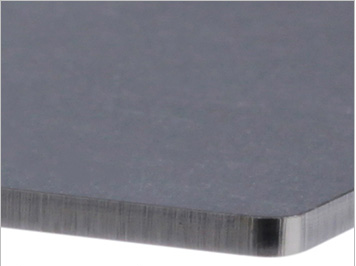
With laser processing The cut surface will have a smooth edge. |
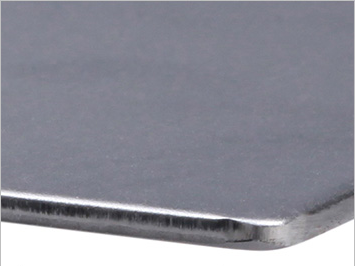
With turret punch press machining The machining surface will have a smooth curved shape. |
 |
Surface
- The external appearance surfaces must be free of blemishes caused by nails.
- For surfaces that are not considered external appearance surfaces, some processing/machining marks may be present.
| Burring in the pulling direction | Damage caused by bending | Protrusion from bending |
 |
 |
 |
Machined Sections (Punching, Bending)
- Any burrs that exceed 0.1 mm that occurred as a result of the machining/processing will be removed.
*Does not include light chamfering or C-chamfering.
- If chamfering or filleting is required on the external sections, include this in the modeling. However, this does not apply to chamfers and fillets in the plate thickness direction.
- Note that the appearance of the cut surface may vary depending on the processing/machining method. (The processing/machining method cannot be specified.)
- Marks may remain from the hanging jig used during the application of the painting coat.
- Machining/processing marks from the die used during the bending process may remain.
*For EN 1.4301 equiv.#400 and EN 1.4301 equiv.(single-sided hairline finish), protective sheets are applied to external appearance surfaces to protect against the formation of defects.
- Bulging/protrusions of about 15% of the plate thickness can occur on each side of the bent sections during the bending process.
Notes on the product appearance
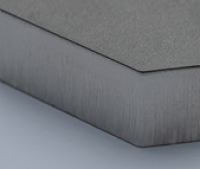 |  |
| EN 1.4301 equiv.(NO.1) plate thickness 12㎜ | EN 1.0038 equiv. plate thickness 16㎜ |
Cutting surface
- For thick plates (over 6.0 mm), burn marks from laser cutting may be noticeable.
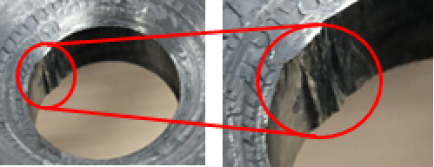 | 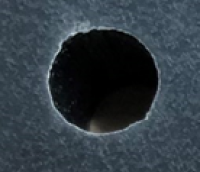 |
| Unevenness inside the hole | Hole shape distored on the back side |
Hole machining
- Unevenness may occur inside the hole. Also, when viewed from the back side of the product, the shape of the hole may be slightly distorted.
Inspection Item
| View of inspection (1) | View of inspection (2) |
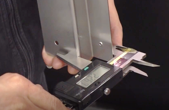 |
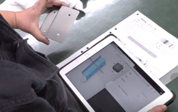 |
Inspection Details
- External appearance inspection: Defects, dents, unevenness, condition of painting coat, condition of surface treatment (visual)
- Dimensional check: Viewer display dimensions (digital Vernier calipers, goniometers, etc.)
- Inspection frequency: As part of each process and immediately prior to shipment
Specifiable Dimensional Tolerances for Sheet Metal/Thin Shim Plates
| No. | Standard Part | Classification of Standard Dimensions | Standard Values* | ||
|---|---|---|---|---|---|
|
Normal Bending |
R-bend (FR bending) |
||||
|
Plate Thicness
≦6.0mm |
Plate Thicness
>6.0mm |
Plate Thicness
≦3.2mm |
|||
| 1 | Section with no bending | 6 or less | ±0.1 | ±0.3 | ±0.1 |
| More than 6, equal to or less than 30 | ±0.2 | ±0.5 | ±0.2 | ||
| More than 30, equal to or less than 120 | ±0.3 | ±0.8 | ±0.3 | ||
| More than 120, equal to or less than 400 | ±0.5 | ±1.2 | ±0.5 | ||
| More than 400, equal to or less than 1,000 | ±0.8 | ±2.0 | ±0.8 | ||
| More than 1,000, equal to or less than 2,000 | ±1.2 | ±3.0 | ±1.2 | ||
| 2 | Section with bending | 6 or less | ±0.3 | ±0.5 | ±0.5 |
| More than 6, equal to or less than 30 | ±0.5 | ±1.0 | ±1.0 | ||
| More than 30, equal to or less than 120 | ±0.8 | ±1.5 | ±1.5 | ||
| More than 120, equal to or less than 400 | ±1.2 | ±2.5 | ±2.5 | ||
| More than 400, equal to or less than 1,000 | ±2.0 | ±4.0 | ±4.0 | ||
| More than 1,000, equal to or less than 2,000 | ±3.0 | ±6.0 | ±6.0 | ||
General Tolerance: JIS B 0408 Grade B (Plate Thickness ≤6.0 mm), Grade C (Plate Thickness >6.0 mm)
- If painting/coating is specified, the standard value for material conditions is used.
- The allowable dimensional tolerances are applicable only for dimensions for between holes on the same face and end-faces/perpendicular-faces that are adjacent as a result of the bending.
*The tolerances are not applicable for hole-to-hole or hole-to-end face dimensions on non-adjacent faces (across multiple bent sections). See “Example of non-applicable dimensions” in the figure below.
| Example | Example of non-applicable dimensions |
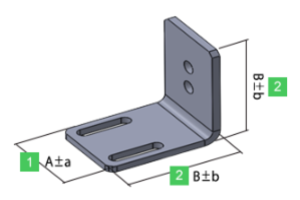 |
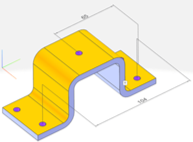 |
Dimensional Assurance Range for Clear Resin
| Standard Part | Tolerance Grade | Classification of Standard Dimensions | Tolerance | |
|---|---|---|---|---|
| Symbol | Description | |||
| Dimensional tolerances for length dimensions, excluding chamfered parts | m | Medium | Equal to or greater than 0.5, equal to or less than 3 | ±0.1 |
| More than 3, equal to or less than 6 | ±0.1 | |||
| More than 6, equal to or less than 30 | ±0.2 | |||
| More than 30, equal to or less than 120 | ±0.3 | |||
| More than 120, equal to or less than 400 | ±0.5 | |||
| More than 400, equal to or less than 1,000 | ±0.8 | |||
| More than 1,000, equal to or less than 2,000 | ±1.2 | |||
| Dimensional tolerances for length dimensions of chamfered parts | c | Rough | Equal to or greater than 0.5, equal to or less than 3 | ±0.4 |
| More than 3, equal to or less than 6 | ±1 | |||
| More than 6 | ±2 | |||
General Tolerance Standards for Machining Dimensions
- The tolerance for the external dimensions is ±1.0. See the table to the left for the tolerances for other sections.
Dimensional Changes for Clear Resin
- For dimensional changes caused by temperature or humidity, accuracy is guaranteed based on the following conditions:
– The inspection is performed in a temperature-controlled environment.– Accuracy assurance is based on the results of inspections performed immediately before shipment.
Clear Resin R
- If the internal angles of the model are sharp corners or are less than R3, machining of around R3 will be applied.
See “Clear resin internal angle (R)” in the figure below - If you would like the internal angles to be finished to a sharp corner or to less than R3, contact meviy support for an estimate.
| Clear resin internal angle (R) |
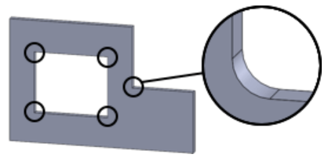 |